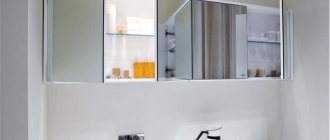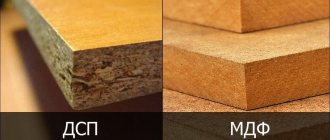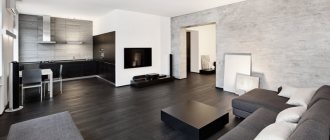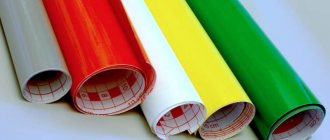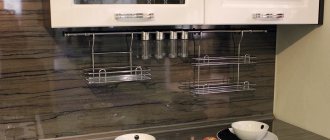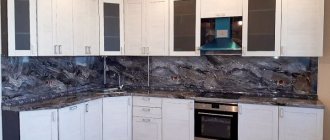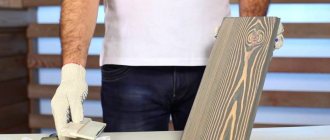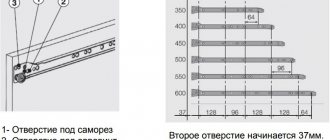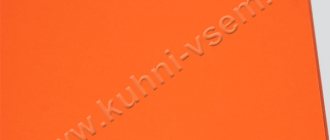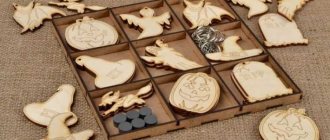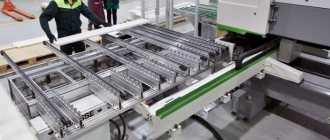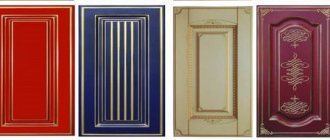Equipment for the production of complex MDF facades
MDF is a relatively new material among similar pressed wood boards.
However, in comparison with fiberboard or chipboard, MDF has better environmental properties. Despite the fact that in the production of MDF, resins are also used as a binding element when pressing wood chips, the emission of harmful substances remains very low (comparable to the emissions of natural wood). That is why MDF products quickly gained popularity in the sector of materials for construction and renovation, as well as for furniture production. The widespread use of MDF is explained not only by its good environmental properties. Due to the high uniformity of the internal structure (which is reflected in the name - MDF from the English "Medium Density Fiberboard", i.e. medium density board), MDF is perfectly processed by cutting. In combination with the use of high-precision and productive CNC machines for processing, this makes it possible to produce a wide range of products. The production of furniture facades on CNC milling machines has become widespread.
Properties of MDF
MDF is a medium density fiberboard. MDF is made by pressing small wood chips - in a sense, it is very dense cardboard. Like all wood derivatives, it is easy to process, easy to mill and sand. MDF is inconspicuous, homogeneous in mass and has no texture. Reliable, time-tested material that has gained its popularity immediately for the following reasons:
For high strength The strength of MDF
is 1.8-2 times
higher than that of chipboard; For safety for humans Emission of formaldehyde in the mass is at the level of natural wood, which is much less than that of chipboard; Due to its excellent mechanical properties, MDF is highly machineable. Excellent milling on CNC machines or with hand tools, drilling. Almost always, MDF parts are produced and prepared for subsequent painting, lamination or veneer finishing. Single-sided or double-sided laminated MDF (LMDF) is available for sale. Different LMDF manufacturers offer their own range of laminates. An ideal choice for the manufacture of kitchen fronts, furniture parts, etc.
Advantages and limitations of using CNC machines
Using CNC milling machines, you can produce furniture facades of almost any complexity. Milling machines provide high precision processing. And the principle of operation of the CNC system (processing according to a programmed program) makes it possible to flexibly configure equipment and quickly changeover for the production of any batch of products - from a mass series to single copies (and going “one after another”).
The advantage of using CNC routers is their versatility. This means that one machine can replace an entire set of equipment. For example, on a CNC milling machine with a fairly large working area (for example, two by three meters), you can carry out the entire range of work with MDF boards - from cutting sheet blanks to the size of the future facade, to finishing grinding the surface and applying a relief pattern. At the same time, a CNC machine will provide high processing productivity, as well as the ability to create quite complex products, including relief artistic carvings!
However, the advantages of automatic equipment are also its disadvantages. This is expressed in the fact that for simple operations (for example, milling a regular linear profile, or even making a paneled facade), the use of a CNC machine may be “redundant.” Considering the time required to prepare the control program, as well as the cost of the equipment itself, for “simple” facades it is easier to use manual milling machines (or devices based on them). And the use of CNC milling machines in the production of MDF facades is justified all the more, the more complex and refined the finished product is required.
For complex MDF facades with artistic surface relief, it would be quite appropriate to use milling machines with automatic tool change. In this case, in addition to the high quality of facade processing, increased production productivity (comparable to the rate of large-scale industrial production) will be added.
Cutting tools for processing complex facades
When producing facades with complex patterns (including relief carvings), shaped cutters are used to provide the required width and depth of “coverage”. The catalogs of milling cutter manufacturers usually indicate examples of facades that are “capable” of this type of tool. If necessary, you can select a tool directly for the desired type of facade.
One important detail should be taken into account. As a rule, shaped cutters have an impressive shank diameter (from 20 mm and above). Therefore, collets of the same size will be needed. Naturally, the milling machine spindle chuck must allow for mounting collets of this size - which can be a problem for low-power (“small”) spindles.
Quite risky, but still a solution is to grind the cutter shank to a smaller diameter (say, from 20 mm to 12 mm). In this case, however, the cutter will lose its “load-bearing capacity” and facades will have to be milled with a reduced load (splitting the processing into several identical passes). This will reduce processing productivity, but will avoid “killing” the spindle of the milling machine.
However, even with a suitable shank diameter, working with router bits requires small changes in the control program strategy. Using the ArtCAM environment as an example, the following sequence is recommended:
- a processing relief profile is created in vector format (for example, in the CorelDraw program);
- the centerline processing mode is selected, the program indicates the current type of cutter;
- the required processing profile is created (taking into account the geometry of the existing shaped cutter);
- the processing depth is adjusted;
- in vector form, a profile is drawn for the cutters to pass through the center (the thickness of the cutter is set to avoid overlap);
- a processing route is created taking into account the thickness of the workpiece being processed (it is advisable to set the zero coordinate from the plane of the work table, and indicate the thickness of the workpiece with an allowance of 1-3 mm - depending on the dimensional accuracy of the source material);
- The created program is launched on the CNC milling machine.
When initially mastering the production of complex facades from MDF, a library of ready-made files (control programs, templates for processing, etc.) will be a good help. As you gain experience, you will be able to move on to “free creativity.” But first, it is recommended to master “copying” known facade models. And only after achieving the required quality, proceed to the production of “your” products.
How to avoid MDF defects when milling?
There are often situations when, during operation, the cutter suddenly begins to “whip” (or chip, undermine) the MDF laminate coating in the cutting areas. This is mainly caused by dull cutters. Moreover, this defect is not so serious as to immediately replace an expensive cutter.
To solve the problem, you can resort to two methods. The first is to increase the cutting depth by 1-2 mm. In this case, the “squat” part of the cutter will have less contact with the laminate, which will have a positive effect on the quality of processing. The second is to have the cutter resharpened. However, during further work, it is recommended to adjust the diameter of the cutter in control programs - after sharpening it will change, albeit slightly.
Introducing the professional stone milling machine 1325 Stone. Starting up the machine, the work process and an example of the finished product in the video.
Visiting our regular client, who produce POS materials and collaborate with major cosmetic brands.
Subtleties of the technological process
Today, the use of milling machines has become ubiquitous. And the advantage of the CNC system is that the milling tools are automatically set in motion, obeying the software setting. Since milling equipment is used to perform curved cutting of MDF, milling of reliefs, three-dimensional figures and images at high processing speed, the preparation for these processes becomes more complicated.
Special requirements apply to electronic drawings in ArtCAM, AutoCAD, Solidworks and Corel Draw (versions 8 to 14), with corresponding extensions.
For curvilinear cutting of MDF and milling of volumetric patterns for facades, a 3D layout is developed, and the files are provided in STL format. For 2D milling, DWG and DXF files are acceptable. This also applies to the option when milled facades are made from MDF for the subsequent assembly of cabinet furniture.
Milling facades for the kitchen: what types are there, what style to choose
Hi all! Today I would like to talk about such a topic as milling facades for the kitchen. I’ll tell you about the types of processing, about the types of facades themselves and more.
Most often, kitchen facades are purchased from MDF, which are painted or coated with PVC film. A more expensive alternative would be a kitchen made of natural wood, which is also often additionally processed using milling machines.
There is a huge variety of patterns on kitchen furniture, which are created using a cutter and special equipment. It is simply impossible to describe literally all varieties. But it is quite possible to do something similar with your own hands, having the necessary equipment at your disposal.
Creating a milled façade
At the stage of creating a kitchen, after cutting out the elements of cabinets and countertops according to the customer’s dimensions, the components are sent for mechanical processing. Using special software, the data of the selected ornament is entered. A CNC machine accurately applies all lines to the furniture façade using cutters. After applying the pattern, when processing MDF facades, the surface is covered with film and laminated. Unlike painted or applied elements, carved ornaments are durable and not subject to mechanical damage. If you decide to buy a kitchen set with milling, be sure that this finish will delight you for many years. Most often, facades can be processed using patterns such as rectangular and rounded frames, strict parallel lines, arches or semi-arches, ovals, stripes, etc. With the help of specialists from the Maria Kitchen Studio, you can choose any ornament suitable for your new kitchen . And our craftsmen will carry out high-quality milling of facades, using the most modern processing technologies.
How a memory foam mattress works, pros and cons, which one to choose
- Processing corners. Milling at the corners is aimed at giving the structure a more attractive appearance. It also eliminates sharp corners. The work requires a cutter with a cutting edge radius of 2 to 3 mm. If a kitchen countertop is being processed, then tools with a radius of 10 mm or more can be used;
- Along the edge. This type of milling is carried out using different cutters. It depends on the designer. First, the chamfer is removed to eliminate sharp edges. Next, using different cutters and changing the angle, the desired pattern is created;
- Surface treatment. Provides for the formation of the desired pattern.
Milling requires appropriate special equipment.
The most commonly used machines today are CNC milling and engraving machines. It is on the CNC that you can program the desired design, and the machine will transfer it to the surface of the facade.
There is also a cheaper option. These are milling and copying machines where processing is performed without CNC. Pre-prepared templates are used here. Part of the work is done manually, which increases the requirements for processing accuracy.
Classification
It’s worth starting with the classification of kitchen facades processed by milling, based on the material of manufacture.
In the case of the kitchen, there are 2 main varieties.
Facades based on natural wood . By the way, previously only such products were processed by milling. But since the price is quite high, an active search began for more affordable alternative materials. There is no denying that wood is one of the best materials for making furniture. There are different species and varieties of trees used in furniture production. Stylish, beautiful and expensive. With proper selection, the kitchen will be durable and retain its original appearance.
But 2021 has already passed, 2021 has arrived, and trends indicate that natural wood is gradually fading into the background.
More and more people are interested in affordable but high-quality materials. In terms of operational and external characteristics, film MDF is not much inferior to wood. Additional PVC film sometimes even better protects the base material.
Alas, not every wood is resistant to moisture and temperature changes. Because of this, MDF boards that are milled are increasingly being used in the kitchen.
Which foam rubber to buy for a sofa: what to look for
Facades based on MDF . This is the second version of the facades under consideration. MDF facades with milling acquire a varied appearance. In terms of technical and operational characteristics, wood is no longer inferior, since modern production technologies have brought the material to a new quality level. First, an MDF board is made, after which the product is processed on a milling machine. The required pattern is created on the surface.
After processing, it is necessary to complete the manufacture of the kitchen facade.
And here several more options appear.
Decoration
If we talk about milled MDF facades, simply cutting out a pattern on the surface with a milling cutter is not enough.
It is important to present the product in a modern style, in Provence style, make it with patina, or present it in a neoclassical style.
To do this, use 3 methods of decoration.
- Painted facades. I think you know what it is. This is the process of applying special paints in several layers. Such structures are easy to maintain, well protected from temperature changes, and do not absorb moisture. But this is a rather expensive processing method;
- Film. These are the most common types of decoration for milled facades. The film used is PVC, which can have various decorative properties. Depending on the film, products can be glossy or matte;
- Veneered. They repeat the advantages of wooden milled facades for the kitchen, but are cheaper.
The top decorative layer not only completes the kitchen, but also gives the furniture additional strength, protection and durability.
The cutters set the required pattern, which is displayed on the finished body of the kitchen furniture.
Types of milling
Milling processing differs in the resulting pattern.
There is no clear classification here, but they can be represented as follows:
- Simple. These are milling operations that use simple straight lines and their combinations;
- Double or complex. Figured drawings combined from several elements, creating a complete composition;
- With 3D effect. They imitate certain surfaces and textures. They look really impressive. A new direction in the creation of kitchen facades. Read more here;
- Milling for handles. Special cutouts made for handles and fittings used in the kitchen;
- Children's. Presented in the form of illustrations, animals, cartoon characters, etc.
Also, milling can be presented in different styles, ranging from classic and neoclassicism to Scandinavian style, high-tech and modern.
Studying the catalog of kitchen furniture, many manufacturers offer various samples of MDF. But behind each drawing there is a special program and CNC algorithm. Some options are completely done by hand.
Thank you all for your attention! Subscribe to our website, leave comments, ask questions and tell your friends about our project!
How MDF facades are milled. Milling cutters for MDF facades.
Indexed html links, end-to-end placement, prominent places in the top.
| [td] Various speed modes and milling with cutters with different sections make it possible to decorate MDF facades with design drawings that make each furniture set unique. The procedure for milling furniture facades. Milling of MDF facades includes three stages. It is worth noting that depending on the passage of the cutter and the likelihood of chipping the edge of the workpiece, the stages are implemented in any order. The following stages of the process are distinguished:
Milling machines for facades. Today, the most popular in furniture production are CNC milling and engraving machines, in which, using a special program on a computer, the operator sets the movement vectors of the cutter. It is from these vectors that the pattern required by the designer is obtained on the surface of the facade. Automatic equipment makes it possible to obtain the highest quality of finished products with high productivity. A CNC machine can cut the workpiece, as a result of which there is no need to purchase bulky additional equipment. In addition, on such devices the external contour is processed, holes are cut out, a profiled pattern (or carved pattern) is applied, and finishing is carried out. |
Range of applications for MDF
Due to their ease of processing, MDF boards are a very common material in various production areas. In addition to milling, they can be carved and drilled, painted, laminated and veneered. Panels are used:
- for the manufacture of linings according to the dimensions for armored doors;
- for finishing doors - a pattern is immediately applied with a router to slabs 8, 10 or 16 mm thick, and then a coating. Sometimes it is a PVC film with a wood texture pattern;
- for interior decoration of buildings in the form of wall panels;
- in the manufacture of acoustic system housings;
- for the production of MDF facades, cabinet furniture elements; countertops, wardrobes, design elements for decoration and decoration;
- in the manufacture of parts of non-standard shape and size.
MDF board, imitating the structure of wood, is a lightweight and aesthetic material that has proven itself in use. Milling a facade from this material is not difficult for specialists.
Milling cutters for MDF facades.
Most modern milling machines are designed to install end mills with a cylindrical shank. However, it is always possible to replace the chuck included in the basic configuration and use cutters of a different shape.
Most commonly used cutters:
- Spherical . Used for basic processing of wood panels.
- Groove V-shaped . They are necessary for 3D milling and 3D engraving of the front side of the MDF board. With the help of such cutters, panels are cut evenly and without chips, edges are cut, V-shaped grooves and workpiece edges are milled at an angle of 45°, and chamfers are removed.
- Double cutters with fishtail sharpening. They can be used for clean cutting of laminated boards to avoid chipping. Cutters of this type can be used for rough finishing of a workpiece without vacuum clamping, as well as for drilling.
- Grooved . They help to level the surface of large MDF facades.
When choosing the number and types of cutters needed, you need to take into account the complexity of the project. For example, for conveyor production, a basic set of cutters will be enough. But to create designer drawings, it is worth purchasing the maximum number of a wide variety of cutters.
Types of facade milling and sets of cutters.
Profiling of MDF facades is carried out using straight groove cutters, or special multi-profile cutters, which allow simultaneous cutting of the part and chamfering. Here you may be faced with a choice: purchase cutters with carbide tips, or with cutting edges made of polymer diamond. The choice is quite difficult, since, on the one hand, the short service life of the carbide cutter and low processing speed, and on the other hand, the price is too steep, including for sharpening polymer diamond. Some enterprises, in order to rationally use expensive tools, initially process the MDF sheet with roughing cutters, and then refine the remaining allowance with a finishing cutter.
Processing of the front surface of an MDF facade can be done either with one shaped cutter or with a whole set of groove and engraving cutters, including straight, U-shaped, V-shaped, with a more complex cutting edge geometry. The number and range of sets of cutters for processing MDF facades depend only on the scope of the designers’ imagination and the skill of the milling equipment operators.
For mass production of the same type of MDF facades, you can purchase shaped cutters with a cutting edge made of polymer diamond. If the company specializes in individual orders, then it is best to use cutters for MDF with soldered or replaceable carbide knives. Their range of milling cutters for the manufacture of furniture facades on the market is diverse enough to satisfy the needs of any client.
When replacing a tool, as a rule, a lot of precious time is lost, since it is necessary to reconfigure machines, change processing modes, perform calibration, etc. To reduce labor costs, some cutting tool manufacturers offer universal multi-profile shaped cutters for the production of MDF facades. Of course, the use of such cutters leads to uniformity of products, but significantly increases labor productivity and production volumes.
Source: www.makuha.ru
Options for manufacturing MDF facades
- With preliminary preparation of blanks to size on a format cutting machine. It is designed for cutting wood and MDF, which is then milled.
When creating the ArtMaster control program (DeskCNC for imported CNC machines), a number of parameters are selected:
- tool path and type;
- type and speed of processing, type of approach to the surface, as well as speed of insertion into the material;
- the size of the tool diameter;
- possibilities for additional processing.
After its creation, the workpiece needs to be fixed on the working surface of the milling equipment and the milling work must be done.
IMPORTANT! When preparing MDF boards for processing, you must not forget to add 3-5 cm on each side for fasteners.
Among the types of workpiece fastening, a vacuum table, vacuum suction cups and manual clamps are used. And since the milling of a part is often carried out with several cutters, they are changed manually or automatically, which simplifies the work and the facades are made by 2, 3 and even 4 different cutters.
- Using a CNC router using Nesting technology to optimize the cutting process.
The CNC machining center is capable of performing the processes of cutting, milling, rolling and drilling wood panels from full-size boards during one working cycle. It is possible to reduce waste to a minimum due to the rational placement of parts. To use this technology, a vacuum table and an option for automatic tool change are required.
The technological process uses straight end mills (they are equipped with cutting inserts made of polycrystalline diamond), profile end mills and diamond cutters.
CNC milling of MDF
High-precision curved cutting on a modern CNC woodworking complex using Nesting technology!
We, as official EGGER dealers and manufacturers of cabinet furniture, are well aware of how much MDF parts and facades, which have undergone high-quality milling before decorative processing, mean for the final cost and presentable appearance of furniture products.
Therefore, if your production in Moscow does not have its own woodworking shop, and representatives of the necessary services brazenly inflate prices for materials and work, our company is always happy to come to your aid and offer favorable and convenient conditions for cooperation.
Installation of panels on walls
MDF panels are quite easy to install. The technology implies that a frame is made on a vertical surface, onto which the panels are then attached.
The DIY installation technology is as follows:
- The frame is being made. It should be as even as possible in all places. The better the frame, the smoother and, accordingly, more beautiful the walls will be. The frame can be made of metal slats or wood. The step between the vertical slats should be made based on the width of the panels (most likely, it will not exceed 70 centimeters), and between the transverse ones it should correspond to their length (probably the distance will be about half a meter).
- You need to start installing the panels from the window and, if everything is calculated as correctly as possible, then there should be no difficulties with “fitting”. The panels will be inserted into the frame and fit tightly to each previous one.
- It is important! If it is necessary to cut panels, it is better to cut each one immediately before installation. Even if you are confident in your abilities, you should not cut all the panels to the same size at once. After all, even a slight distortion of the frame will lead to the fact that the first and last element of the structure may differ in height, even by several millimeters.
- It is quite difficult to install the corner of the panels. Therefore, it is best to buy a finishing corner made of MDF. It just needs to be inserted into the grooves of the frame. If there is such an angle, the installation of the next wall will begin with the plank already level.
- With the frame installation method, the panels fit tightly to each other, so there is no need to glue them together. Glue must be used when one of the elements is placed in place of a damaged one in an already assembled structure.
- Glue may be needed when making a simplified version of the frame. You only need to place wooden planks at the top and bottom. MDF panels will be glued to them. This option is as simple as possible, but also less durable.
The most progressive method of attaching panels, planks that resemble clapboards, to the wall is the one that uses a special clamp - a clasp.
The panels are initially wider than the slats. They are used for cladding walls where they want to create an interesting pattern. Panels are selected by color. It is quite acceptable to use panels for walls even when a single-color wall is made.
Working with such material is somewhat more difficult than with planks, however, it is quite simple. This cladding is used for technical rooms, corridors and offices. With high-quality installation, the structure will be durable, and during normal operation it will not require repairs.
In the video you can see how the installation of MDF wall panels is carried out:
Ceiling installation
MDF panels and strips can be placed on any part of the interior space of the room. The ceiling is no exception. It does not require any additional processing. But here you definitely need a frame into which the structural elements will be inserted. It would be great if the clasp acts as a connecting element between the panels.
Installation is usually quick, provided that the frame is of high quality and the pitch between the slats is correctly calculated. One of the features of MDF is that this material, despite its strength, lends itself to many processes that allow it to be decorated and even radically changed.
Clasps for panels
The special bracket is made of galvanized or stainless steel. It must have the necessary rigidity to be able to hold MDF strips nearby, which can be positioned vertically or horizontally.
The technology for using clasps is simple, but it requires compliance with all installation rules:
- A transverse frame is made. This is when the strips are installed only at the top and bottom.
- The first panel is placed in the grooves of the frame. It is important to accurately check its relationship to the floor, ceiling, and corner.
- Now you need to insert a clasp into the groove of the panel, which will be adjacent to the next sheathing element.
- The next element is mounted end-to-end to the previous one and its groove should fit tightly into the clasp.
The longer the structural elements, the more clasps there should be on the panel. The optimal distance between fastenings is half a meter. Correct installation means that the clasp will not be visible at all.
The use of such fastening allows you to extend the life of the structure, prevent movement of its elements and ensure the highest quality installation. How to attach the panels needs to be decided in advance in order to prepare everything necessary.
Our advantages are your benefit
Blanks and facades made of fibreboards processed in our production will allow you to make/manufacture high-quality furniture and other MDF structures, minimizing costs as much as possible and reducing production time.
- – official representative of EGGER in Moscow. By cooperating with us, you receive double benefits:
- services of experienced milling operators who perform a full range of specialized and related work related to the processing of MDF products,
- necessary materials and furniture fittings of European quality at a price lower than the market price by 5-18%.
- Our production base is equipped with a powerful modern CNC woodworking complex, which allows us to quickly, without defects, perform milling operations of any complexity.
- CNC milling of MDF is carried out using Nesting technology. That is, in the shortest possible time, we will be able to perform for you a large (necessary) number of technological operations at one DC and provide you with parts that are actually ready for final assembly.
- We work equally successfully with both large enterprises and private craftsmen. We carry out orders from piece items to industrial quantities.
- Advantageous location of office, warehouse and production, next to Yegoryevskoe highway.
Router-copier
Anyone who has cut out a large number of identical parts with a jigsaw probably knows how tedious this monotonous work is. Using a hand router, you can simply copy the required number of parts! The main thing is to prepare the template well and efficiently. And then, we take and install into the router the copying sleeve that comes with most models. We fix the template on the material and copy, copy, copy...
This task is feasible for milling cutters with low rated power:
You can decorate furniture fronts with an interesting pattern using a template and a copy sleeve. The main thing is that all the parts will be exactly the same, and their production will not take a lot of time. The main efforts should be directed to carefully preparing the template!
Technical capabilities of Wood Market for milling MDF
We confidently guarantee the highest quality of every detail and prompt execution of even the largest orders.
Curvilinear cuts and filler operations are carried out on multifunctional CNC woodworking machines from HOMAG WEEKE. The water cooling system of the main milling spindle of our nesting allows us to maximize the speed of work without damaging the material being processed or compromising the quality of the cut.
Multi-operational work without resetting, in flow mode, is carried out on the OPTIMAT BHX 050 drilling and additive unit (more than 100 different additive cards can be programmed simultaneously).
Ultra-precise and accurate finishing of edges at the ends in single and continuous modes is carried out on a Hebrock edge banding machine.
In addition to additives and drilling of holes (from 3 mm in diameter), we offer:
- Curvilinear milling and edging of parts;
- Groove for HDF/MDF (3 mm),
- Gluing 2 plates + plastic sticker;
- End bevel (45 mm.)/groove (4 mm.);
- Quarter under MDF/HDF.
Various milling options available:
- standard,
- artistic (complex details with specific contours),
- engraving,
- any others according to your sketches.
Finished parts are packaged in corrugated cardboard or stretch film costing from 15 rubles/sq. meter
MDF milling
The most optimal method for curvilinear cutting of MDF is milling using our woodworking milling machine. Milling MDF , compared to manual methods of processing this material, simplifies and speeds up the process of manufacturing non-standard products from it. Call us and we will always advise you on all questions related to MDF milling. Our services are not limited to MDF milling; we can also offer the assembly of advertising and other structures.
Prices for MDF milling
Material
Thickness, mmCost of MDF milling, rub. per m/p: up to 500 from 5003-65045407-1065605512-2070656020-30858075The cost of milling MDF is indicated in Russian rubles without VAT per linear meter. The cost of the order is calculated based on the thickness of the material, the product of all cutting lines and the cost of a linear meter taken from the table. You can bring MDF for milling to us for production or order the material through us and we will give it the required shape and size by milling.
About the material
MDF or fiberboard is a medium-density board material made by dry pressing fine wood chips at high pressure and temperature. Melanin-modified urea resins are used as a binding element. This ensures very low formaldehyde emissions, comparable to those of natural wood. MDF is made fire, bio and water resistant. MDF is 1.3-1.5 times more expensive than chipboard, but nevertheless, it is more profitable to use, MDF emits substances hazardous to health many times less - no more than 10 mg per 100 g of dry surface of the board. In addition, the strength of MDF is 1.8-2 times higher than the strength of particle boards. The density of the material ranges from 600 kg/m³ to 800 kg/m³.
Features of CNC milling of MDF
One of the most important advantages of MDF is the high manufacturability of this material. The plate is easy to mill and allows you to make beautiful panels, rounded corners, etc. Parts can be given a wide variety of shapes, which significantly expands the capabilities of furniture manufacturers when constructing and developing furniture designs. MDF is ideal for 3D milling of cavities of various depths, curved holes and other curved shapes because during milling it emits dust, not chips. For milling and processing of MDF, 1-way spiral cutters with chip removal downwards and 2-way compression spiral cutters with a diameter of 6 mm are used. The spindle rotation speed when milling MDF is about 21,000 rpm.
CNC milling of MDF is used for
- Construction and renovation
- Furniture production
- milling of facades with carving elements
- production of speaker enclosures
- production of commercial equipment
- production of packaging, gift boxes
- advertising structures, POS materials
Our equipment
From us you can order milling and cutting of MDF on a new woodworking milling and engraving machine with a working field of 2050x4050. MDF milling in Moscow and the Moscow region. An attractive price and quality of milling work performed for you.
Source: frezmaster.ru
Milling of products from MDF and chipboard
Do you want to see furniture facades with unusual patterns, interior doors with relief, or even unique ceiling panels in your home, but don’t know where to order high-quality MDF and chipboard processing? "Frezer365" is a workshop that mills wood-containing slabs of any type. We work both with our own MDF and chipboard blanks, and with materials provided by the customer. The slabs are milled on professional-class CNC (computer controlled) machines - Precix 11100, Bigzee GL 2030 and Bigzee GL 1620.
We offer:
- from 20 rubles per linear meter – the price of milling MDF and chipboard;
- from 1 to 3 days – order fulfillment time;
- 3D, classic, multi-component - any types of milling.
Prices for milling MDF and chipboard
The cost of milling for each client is calculated individually. The price depends on the volume of work performed (number of copies made), its complexity and urgency.
Note!
The standard turnaround time for milling chipboard and MDF is 3 days. Urgent orders are completed within 1 day and are subject to additional charges.
| Material | Material thickness (mm) | Price per linear meter (rub.) |
| MDF/chipboard | 3-6 | From 20 |
| 7-10 | From 24 | |
| 12-20 | From 35 | |
| Thickness more than 20 | Negotiated separately |
* Minimum order – from 2000 rubles.
* The table shows prices per linear meter (lm).
How to order the service of milling chipboard and MDF on CNC machines?
To order milling of MDF or chipboard boards, use the “Place an order” button and fill out the application. To find out the preliminary cost of the work, click on the “Calculate cost” button. You can also clarify the information you are interested in with our manager by calling us by phone (see) or ordering a call back.
Our workshop is open without holidays or weekends; we can accept your order and begin its execution on any day convenient for you. We also accept applications received by email 24 hours a day.
Scope of application for milling MDF and chipboards
Milling on a CNC machine is a fast and effective way of artistic processing of wood-containing slabs, which allows you to:
- drawings of any complexity on furniture facades and individual furniture elements - cabinet doors, headboards, tabletops, etc.;
- figured grilles, volumetric reliefs, linings on interior and entrance doors, platbands;
- partitions for zoning premises;
- wall and ceiling panels;
- decorations, various decor.
Recommendations for designing a product layout (template)
Milling of slabs is carried out according to the provided layout. If it is designed incorrectly, this can lead to distortions in the parameters in the finished product and misunderstandings. To avoid such situations, please read the layout guidelines:
- file format - EPS, AI, CDR, DXF, DWG for classical and multi-component milling; STL and STEP for 3D milling;
- raster objects are not allowed in the layout;
- layout scale - 1:1, distance must be indicated in millimeters;
- the distance between the contours of objects is at least 5 mm, between objects is at least 8 mm, the distance from the edge of the workpiece is 15 mm around the perimeter;
- The curvature radius of the 6 mm cutter must be observed - 3 mm (in some cases, a 1.5 mm cutter with a curvature radius of 0.75 mm is used).
You can find complete recommendations for designing a product layout on this page.
Note!
You can order the development of a product layout by our specialist. The cost of the service is from 1000 rubles, depending on the complexity.
Requirements for processed MDF and chipboard boards
The quality of the finished product primarily depends on the material used. We process our own blanks or use material provided by the client. Requirements for the processed material:
- dryness, otherwise the slab will crack and deform after a while after processing with a milling cutter;
- absence of visible and hidden defects;
- free margins - more than 10 mm from the image outline;
- flat surface, deviation of the sheet from the plane - no more than 0.2 mm.
Note!
If the workpiece is larger than the working fields of our machines (1530 x 3150 mm, 2080 x 3100 mm, 1600 x 2050 mm), there is no need to cut it. We ourselves will adjust the material to the required dimensions.
Milling MDF and chipboard in the Frezer365 workshop in Moscow
Our company performs work on milling MDF and chipboard panels. Due to good technical equipment and professionalism of employees, we offer:
- high-quality high-precision milling of wood-containing slabs;
- affordable prices;
- creating layouts for milling;
- fast completion of work within 1 to 3 days.
To place an order or calculate its cost, please use the appropriate forms above. You can also get advice by contacting us by phone (view) or ordering a call back.
Source: frezer365.ru
